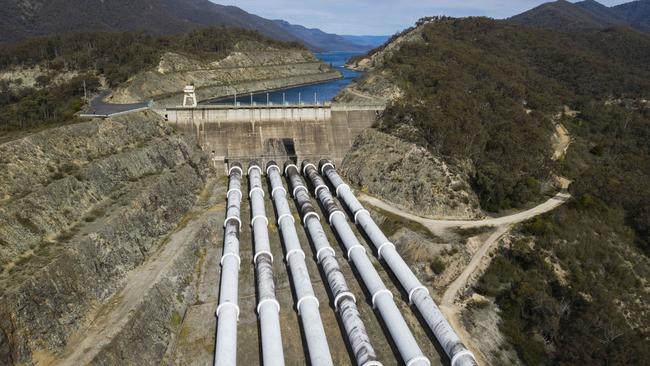Construction contractor Clough feels the pressure amid Snowy 2.0 cost blowout
Wrangling over $2.2bn in unpaid claims on the Snowy Hydro scheme is putting pressure on one of Australia’s oldest civil construction companies.

Wrangling over $2.2bn in unpaid claims on the Snowy Hydro scheme is putting pressure on one of Australia’s oldest civil construction companies, amid an executive exodus and complaints from subcontractors about unpaid bills.
The Australian has confirmed that half a dozen senior Clough executives, including chief financial officer Richard Simons and group general council Christian Ainslie, have left the civil engineering contractor since June. Since then the company has also lost the services of Martin Siddle, vice-president of its US business, and the vice-president of its WA and Asian operations, Paul King.
Industry sources say the wave of executive departures is adding to mounting problems at the contractor, which is also facing potentially significant losses through its 30 per cent share of a joint venture to construct the Snowy Hydro expansion in NSW.
The joint venture partners are locked in discussions over an estimated $2.2bn in additional payment claims over cost overruns caused by the Covid-19 pandemic.
The company is also locked in a $106m legal dispute with Rio Tinto after another joint venture, with Asciano, was terminated from a rail construction job in the Pilbara region of Western Australia. Clough also faces the prospect of significant delays to a $US2.7bn ($3.9bn) contract held in a joint venture with Saipem, to design and build a Perdaman Chemicals urea plant in the Pilbara.
Industry sources say Clough was counting on up to $250m in revenue from the project flowing into its books in the current year.
However, work is now stalled as federal Environment Minister Tanya Plibersek considers whether to intervene under heritage protection laws after traditional owners of the area raised concerns the plant could add to damage to rock art on the Burrup Peninsula.
The Australian has also seen evidence of complaints from a number of smaller sub-contractors working on Clough-led projects about tardy payments, including threats to withdraw services or remove equipment from worksites.
A spokeswoman for Clough said on Monday that the recent turnover in Clough’s senior executive ranks was “no different to others in the industry”. “Certainly, in the last 12 months we’ve experienced turnover in our workforce, but this is no different to others in the industry, with some very attractive opportunities being offered to talented people from Clough,” she said.
Clough did not directly address concerns raised by suppliers about payment delays, or whether the company faced a credit squeeze as a result, but the spokeswoman said issues posed by supply chain disruptions and rising costs such as labour and fuel were common across the construction industry.
“While this has created a challenging scenario, Clough continues working collaboratively with all of our clients and vendors to mitigate these impacts and continue delivering successful projects,” she said.
“Despite these challenges, we are still on track to post a positive result for the year, and we’ve entered the new financial year with the strongest order book in Clough’s history.”
There is no suggestion that, despite Clough’s troubles, the company is in any danger of collapse. Clough chief executive Peter Bennett told staff in July the company remained debt-free and was expected to book earnings of about $35m for last financial year when its accounts were finalised.
The most recent accounts of Clough’s parent company, South African-listed Murray & Roberts, lend weight to suggestions the company has been dealing with falling levels of cash, however.
Clough’s 2021 financial accounts, filed with the corporate regulator last year, show the company made a $20.8m net profit and held cash of $246.3m at June 30, including “Clough controlled cash of $198.9m and cash held by joint arrangements of $47.4m”.
Clough’s cash levels had fallen to $141m by the end of December 2021, according to an accounting note contained within Murray & Roberts half-year accounts, with $100m of that required to be held “unencumbered” under the terms of performance bonds extended to the contractor by HSBC.
The contractor’s situation is understood to be the subject of close monitoring within the energy industry, given Clough’s role in not only the Snowy Hydro project but other politically sensitive energy projects.
Clough is also a joint venture partner with Elecnor in a $1.5bn contract for the engineering, procurement and construction of Transgrid’s EnergyConnect project, designed to provide a link between the South Australian and NSW energy grids and open up the National Energy Market to new sources of renewable power.
Transgrid last week announced plans to try to bundle together its work on three major transmission projects – EnergyConnect, the VNI West interconnector between Victoria and NSW, and the Humelink in NSW – in an effort to accelerate their delivery and shave some $500m from construction costs.
All three are central to the government’s $20bn Rewiring the Nation Plan, aimed at both reducing carbon emissions and stabilising the NEM as more renewable energy enters the grid.
The potential budget blowout at Snowy 2.0 underscored the massive challenge of delivering a mega-project amid the Covid-19 pandemic, cost inflation and labour shortages, APA chairman Michael Fraser said on Monday.
The two companies are working together on Snowy’s planned Hunter gas plant near Newcastle, including a 30-year pipeline and storage deal that will deliver supplies from late 2023.
Any delays and cost increases on the Snowy 2.0 expansion would threaten the power grid, given the tight market and need for storage to back up renewables, Mr Fraser said. “If there are delays at Snowy 2.0 that just highlights the reliability issues that we are going to face. To me the real question is how quickly coal can be replaced. And major projects have a long history of running late and costing more.”

